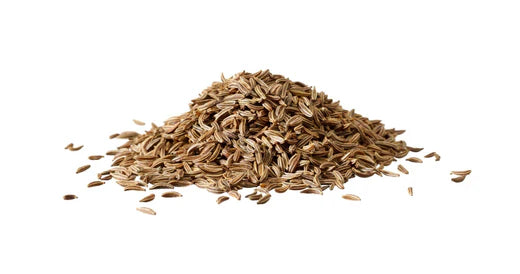The biennial Carum carvi plant is a member of the Apiceae or Umbliferrae family. The plant resembles a carrot plant, with finely divided feathery leaves with divisions-like threads and a 20–30 cm stem. The main flower stem is 40–60 cm long and has umbels of tiny white or pink blooms. In India, there are three different species of fruit: C. Carvi, which produces large, laterally compressed fruits; C. gracile, which has smaller, dorsally compressed fruits; and C. bulbocastanum, which produces smaller, darker fruits. Caraway fruits are crescent-shaped achenes (also known as seeds), measuring around 2 mm long and having five light ridges. Its root, which is regarded as a tap root, has a slender appearance and measures 8 to 9 inches long. When cooked, it changes from a yellow color to a rich, creamy white tone.
General Description
It is one of the spices that Indian cuisine uses the most. It has a long history of use and is quite valuable medicinally. To provide flavor and scent to food, it is used in cooking. However, we never consider the healing properties of caraway or jeera. All food items are regarded as medicines in Ayurveda since they assist bodily functions. Let's talk about Krishna jeeraka's effects on general health.
It possesses a number of medicinal qualities, including astringency, analgesia, stomachic, carminative, and fragrant. Its environment is cooling. Sanskrit refers to cumin as Jeeraka, which comes from the word jeerna, which implies digestion. Jeerak, which means to digest, aids in the treatment of digestive tract diseases. It is regarded by Ayurveda as an appetizer, stimulant, fortifying, and beneficial for the eyes and brain as well as enhancing breastfeeding. Heart conditions, inflammations, nausea, indigestion, and prolonged fever are also helpful. It has a mild, dry flavor that is bitter. It is really potent.
Black cumin is also known as Carum bullbocastanum, Bunium bulbocastanum, Black caraway, and Nigella sativa, often known as simple nigella, kalonji, and little fennel.
Kali jeera seeds contain 40–60% volatile oil. Cuminaldehyde (45.4%) and p-cymene (35%) make up the majority of an essential oil's chemical composition, while carvone, limonene, a-pinene, beta-pinene, cymene, and terpinene are minor components. Flavonoids, quercetin derivatives, polysaccharides, and calcium oxalate are other components.
Its oil contains omega-6 linoleic acid, thymoquinone, nigellone, melanthin, nigilline, damascenine, and tannins in addition to being beneficial for skin tone and hair growth. By increasing the production of prostaglandin E, it is also beneficial in the treatment of erectile dysfunction.
The fruits are employed in the creation of several beverages as well as in medicine, the perfume business, and baking. Caraway oil is mostly used to flavor wine, scent soap, and create fragrances.
Classification
Botanical name - Carum carvi
Kingdom - Plantae
Sub kingdom -Viridiplantae
Division - Tracheophyta
Class - Magnoliopsida
Order - Apiaceae
Genus - Carum
Species - Carvi
Order - Apiales
Family - Umbelliferae
Habitat
This plant can be found in the northern Himalayas. It is grown in plains during the cold season and in highlands like Kashmir, Chamba, and Garhwal during the summer at elevations of 3000–4000 meters.
Other Names
Latin name: Carum carvi
Common name: Krishna jeerak, Kala jeera
Sanskrit: Krishna jeeraka
Hindi: Syahjeera, Kali jeera
Kannada: Karijireege, Shahajirige
Tamil: Karamjeeragam, Shimayishiraga
Telugu: Sheemajilkar
Malayalam: Karunjeeraka, Karinjeerakam
English: Black caraway, Black cumin, Indian caraway
Bengali: So-jeera
Persian: Jeerya-riza, Zira
Marathi: Shahaajire, Jeere
Arabic: Kamuna, Kamoonearamani
Esperanto: Karvio
Francais: Carvi
Gujarati: Shaahjeeru
Italiano: Carvi
Kashmiri: Krihunzur
Kurdi: Jaj
Latina: Carecum
Latviesu: Plavas Kirnene
Magyar: Kormerry
Nederlands: Karwij
Norsk: Karve
Origa: Kalajira
Polski: Krninek Zwyezajrry
Portugues: Alcaravia
Punjabi: Zira Siyah
Roman: Chirnan
Shquip: Qumnoni
Slovencina: Rasca, Kumina
Suomi: Kumina
Svenska: Kummin
Urdu: Zirasiyah, Kalajeera
Veneto: Kumo
Ayurvedic Properties
|
Particular |
Hindi / Sanskrit |
English |
|
Rasa (Taste) |
Katu |
Pungent |
|
Guna (Qualities) |
Laghu, Rooksha |
Light, dry |
|
Virya (Potency) |
Ushna |
Hot |
|
Vipaka (Post-Digestive Taste) |
Katu |
Pungent |
Effects on Doshas
Kaphavatahara enhances pitta doshas in the body while calming down vitiated Kapha and Vata doshas.
Classical Categorization
|
Charak Samhita |
Sushrut Samhita |
|
|
Practical Uses
- Vomiting is a very effective treatment for liver and stomach issues.
- It serves as a uterine antiseptic.
- Indigestion and inflammatory bowel syndrome (IBS) can be treated with it.
- Jaundice can be effectively treated with it.
- It stimulates the appetite for food.
- It has anti-inflammatory qualities because it boosts histamine secretion.
- Additionally, it helps with diarrhea, bloating, gas, and dysentery.
- Because it includes sitosterol, it has a protective effect against breast cancer.
- Removing the Kapha from the uterus effectively heals dysmenorrhea and irregular menstrual cycles.
- During breastfeeding, it is used as a galactagogue to promote milk supply.
- Disorders of the nervous system and the brain can be calmed by it. It improves mental agility and focus.
- It helps with headaches brought on by the Kapha dosha and is healthy for the eyes.
- In the treatment of gingivitis, it is helpful. Gum irritation, swelling, or redness are all symptoms of gingivitis.
- It is applied to the management of persistent fever phases.
- It is used to treat conditions including anorexia, emesis, appetite loss, flatulence, abdominal pain, and hemorrhoids that are brought on by Agni disruption.
- It is also employed as an expectorant, encouraging the airways to secrete phlegm, and as a cough suppressant.
- It possesses qualities that encourage menstrual flow.
Part Used
Seeds, Fruit
Dosage
1/2- 2 gm

